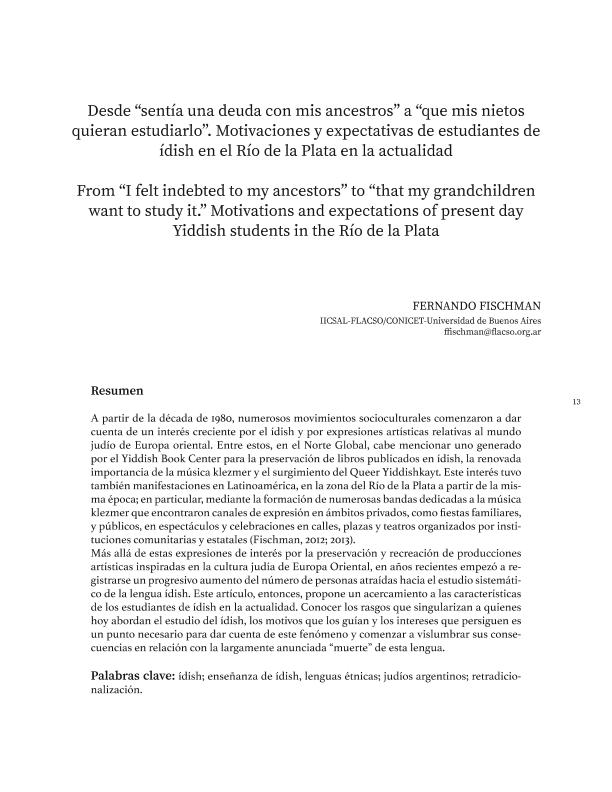Artículo
A partir de la década de 1980, numerosos movimientos socioculturales comenzaron a dar cuenta de un interés creciente por el ídish y por expresiones artísticas relativas al mundo judío de Europa oriental. Entre estos, en el Norte Global, cabe mencionar uno generado por el Yiddish Book Center para la preservación de libros publicados en ídish, la renovada importancia de la música klezmer y el surgimiento del Queer Yiddishkayt. Este interés tuvo también manifestaciones en Latinoamérica, en la zona del Río de la Plata a partir de la misma época; en particular, mediante la formación de numerosas bandas dedicadas a la música klezmer que encontraron canales de expresión en ámbitos privados, como fiestas familiares, y públicos, en espectáculos y celebraciones en calles, plazas y teatros organizados por instituciones comunitarias y estatales (Fischman, 2012; 2013).Más allá de estas expresiones de interés por la preservación y recreación de producciones artísticas inspiradas en la cultura judía de Europa Oriental, en años recientes empezó a registrarse un progresivo aumento del número de personas atraídas hacia el estudio sistemático de la lengua ídish. Este artículo, entonces, propone un acercamiento a las características de los estudiantes de ídish en la actualidad. Conocer los rasgos que singularizan a quienes hoy abordan el estudio del ídish, los motivos que los guían y los intereses que persiguen es un punto necesario para dar cuenta de este fenómeno y comenzar a vislumbrar sus consecuencias en relación con la largamente anunciada “muerte” de esta lengua. Starting in the 1980s, numerous sociocultural movements began show a growing interest in Yiddish and artistic expressions related to the Eastern European Jewish world. Among these, in the Global North, it is worth mentioning the renewed importance of klezmer mu-sic, the Yiddish Book Center for the preservation of books published in Yiddish, and the rise of Queer Yiddishkayt. This interest also had its manifestations in the Río de la Plata region, in particular through the formation of numerous bands dedicated to klezmer music that found channels of expression in private spheres such as family parties and public spheres such as shows and celebrations in streets, squares and theaters organized by community and also state institutions (Fischman, 2012; 2013).Beyond these expressions of interest in the preservation and recreation of artistic produc-tions inspired by Eastern European Jewish culture, there has been a growing increase in the number of people attracted to the systematic study of the Yiddish language in recent years. This article approaches the characteristics of Yiddish students today. Knowing the features that distinguish those who study Yiddish at present, the goals that guide them and the inter-ests they pursue is a necessary point of departure to account for this phenomenon and begin to glimpse its consequences in relation to the widely announced “death” of this language.
Desde “sentía una deuda con mis ancestros” a “que mis nietos quieran estudiarlo”. Motivaciones y expectativas de estudiantes de ídish en el Río de la Plata en la actualidad
Título:
From “I felt indebted to my ancestors” to “that my grandchildren want to study it.” Motivations and expectations of present day Yiddish students in the Río de la Plata
Fecha de publicación:
12/2023
Editorial:
Universidad de Chile
Revista:
Cuadernos Judaicos
ISSN:
0717-4357
e-ISSN:
0718-8749
Idioma:
Español
Tipo de recurso:
Artículo publicado
Clasificación temática:
Resumen
Palabras clave:
ÍDISH
,
ENSEÑANZA DE ÍDISH
,
LENGUAS ÉTNICAS
,
JUDÍOS ARGENTINOS
Archivos asociados
Licencia
Identificadores
Colecciones
Articulos (IICSAL)
Articulos de INSTITUTO DE INVESTIGACIONES SOCIALES DE AMERICA LATINA
Articulos de INSTITUTO DE INVESTIGACIONES SOCIALES DE AMERICA LATINA
Citación
Fischman, Fernando Damián; Desde “sentía una deuda con mis ancestros” a “que mis nietos quieran estudiarlo”. Motivaciones y expectativas de estudiantes de ídish en el Río de la Plata en la actualidad; Universidad de Chile; Cuadernos Judaicos; 41; 12-2023; 13-35
Compartir
Altmétricas




